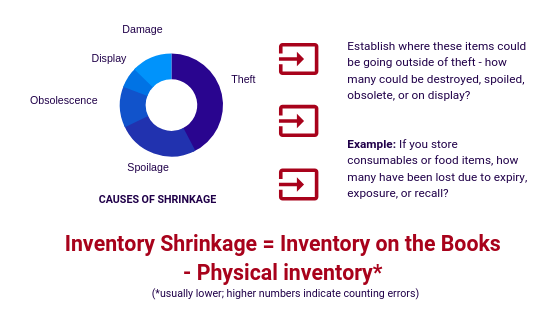Warehouse Theft Prevention: 8 Tips to spot it and stop it


Most businesses with warehouse components suffer a great deal loss due to inventory shrinkage caused by theft within the warehouse, by their own internal employees. This goes with the territory in all regions, including the Middle East and Africa, and reducing the cost of these losses is entirely possible with the right tools and processes.
That said, there’s no single, simple solution to prevent warehouse theft. It takes a combination of strong processes, security systems, warehouse management software and excellent hiring criteria to reduce theft in your business.
Start tackling warehouse theft by ensuring you can spot it:
Ensure that your inventory is correctly tracked so that you can tell the difference between the types of losses you may suffer, by combining stock takes and cycle counts to accurately assess your inventory on the books.
Stock take vs. cycle counting, and how they help to prevent warehouse theft
Your WMS allows you to be more flexible in your warehouse, moving from traditional stock take methods to cycle counting.
The main benefit of cycle counting is that it doesn’t require you to shut down your entire business.
Cycle counting ensures that your inventory is frequently checked for accuracy - without interrupting your operations. You simply count small subsets of inventory in various locations in your warehouse, on an immediate, daily or weekly basis. Not only is this a more productive and efficient method of inventory control, it’s easier to spot theft because you can spot discrepancies sooner rather than later.
Once you have these processes down pat, you can assess where your stock is going:
Missing stock vs. theft: how to tell the difference
Inventory shrinkage in your warehouse is normal, within certain limits. There are many reasons why you’re experiencing inventory loss - as you can see in the diagram below:

“Incidents involving the theft of full truckloads continued as the most prevalent method of cargo theft in the third quarter of 2016, representing 78 per cent of all reported thefts with an average loss of $120,298. Facility thefts saw a 98 per cent increase in theft rate and a 266 per cent increase in theft value. Warehouse locations remained the most commonplace for cargo theft. Holiday weekends saw a 40 per cent increase in cargo theft cases, probably due to large shipments in anticipation of holiday sales” reports LPM Insider.
The best way to identify theft in your warehouse is to conduct regular stock takes.
The more accurate your inventory data, the faster you’ll pick up on theft. Without regular stock takes, you may not even notice that inventory levels are shrinking suspiciously until months down the line - by which time you’ll be hemorrhaging cash.
Look out for the following red flags that could indicate warehouse theft:
- Your stock levels don’t match your sales records.
- Sales seem to dip on days when particular staff are on duty.
- Staff rumours suggest theft is taking place.
- Certain team members avoid taking their annual leave.
- Important documentation (such as invoices) are missing or appear as duplicates rather than originals.
- Stock is constantly found near exits or loading bays.
It is very difficult to prove that someone is guilty of warehouse theft without catching the person red-handed. It’s much easier to put security measures in place which help you avoid theft altogether.
If you notice any discrepancies, look into them immediately. The longer you leave it, the harder it will be to ascertain whether the missing stock items are lost or stolen.
It's easier to do this with decent data:
Knowing where your stock is, or isn’t, is critical, and from this point, we advise taking precautionary measures to raise awareness, identify weak points and limit the opportunity for theft.
Tips to prevent warehouse theft in your business
1. Conduct background checks before hiring new warehouse staff.
It might seem like a no-brainer, but doing a basic background check on criminal records will drastically decrease your chances of warehouse theft.
“Numerous subsets of screening services may be included in an employment background check. Which ones you choose will depend on a whole host of variables, including the nature of your industry, nature of your business, what kind of role you’re hiring for, wherein the corporate hierarchy that role falls, and your organisation’s level of risk tolerance. Beyond that, you should be mindful of the laws and regulations affecting your organisation.”
“The bottom line is that when they’re done properly, background checks can help ensure the integrity, fairness, and consistency of the hiring process. That’s good for those doing the hiring, of course, but it also benefits honest candidates who are playing by the rules and giving employers an accurate picture of themselves and their qualifications.”
- Gulf Business
Check the criminal history of potential employees as well as checking with previous employers to find out how long the person worked there and why they left. Trust your gut - if you’re not sure about someone’s credibility, don’t hire them.
2. Educate employees about company policy on theft.
Make sure all your staff are aware that you have a zero-tolerance policy when it comes to theft or fraud. Have them sign a code of conduct that clearly outlines how violations will be punished.
Additionally, you can identify anonymous channels for staff to report any suspicious activity. If everyone knows that their colleagues are keeping an eye out, it will deter thieves due to a higher chance of being caught.
3. Deal with thefts immediately, in line with your company policy.
If you experience a theft, or series of thefts, take a look at your shift register to see who was on duty when the stock went missing. If you begin to notice a pattern between missing stock and certain staff members on duty, monitor their activity in the warehouse.
If you notice any suspicious behaviour (such as consistently clocking in or out at odd times) then you may need to investigate further. This can be done in-line with the company policy education and process.
4. Maximise managerial visibility in your warehouse.
Having a strong managerial presence on your warehouse floor will deter theft. It can, however, be difficult for warehouse managers to spend a lot of time on the floor, as many of their duties require a computer.
Consider investing in a warehouse management solution that offers a mobile component, this would allow warehouse managers to a desk free solution. The DM Mobile Solution offers a couple of advantages for managers as they walk the floor:
- Systematically record active interactions with employees, including observations and performance measurement.
- Review work in the warehouse by wave, job function and task/activity.
- Put a task on hold, re-prioritize a task, assign a task to an employee or release a set of tasks to be completed.
- Monitor, plan and forecast work in real-time.
- Track the status for a particular customer, including order look-ups and wave progress.
Your warehouse management solution should be mobile-enabled so that your warehouse managers aren’t completely desk-bound. This will help you increase visibility and interaction on the floor.
Additionally, you can locate your manager’s office above your warehouse, on a mezzanine floor, with a bird’s eye view of the warehouse below. This allows managers to keep an eye on the warehouse floor at all times.
5. Limit access to stock in your warehouse
Use the physical layout of your warehouse to create barriers that help to prevent theft. Separate your receiving and shipping docks where possible, to prevent newly received stock exiting on an outbound truck before it even enters your warehouse.
Keep your pick faces and inventory storage locations as far away from your shipping and receiving areas as possible. The only stock that should be near these areas are incoming and outgoing orders.
Provide visiting truck drivers with a dedicated lounge area to wait while orders are being loaded or unloaded. Only staff should have access to your warehouse or distribution area.
6. Ensure you have robust security systems in your warehouse
Installing security systems like access control and CCTV cameras not only deter criminals but also provide evidence of the theft that is caught on camera. These cameras should be strategically placed in high-risk areas. You can also install security mirrors to maximise visibility and prevent blind spots in hard to reach corners of your warehouse.
Additional security measures like unplanned warehouse walk-throughs by supervisors, team leaders or management can act as an additional deterrent. Make sure these walk-throughs are completely unpredictable. Some key areas to check include shipping and receiving bays, and entrances and exits.
Security personnel should be stationed at every entrance/exit to the building. Be sure to inspect any vehicles leaving your warehouse to check for any unauthorised stock leaving the premises.
Staff and visitors’ parking should be located separately from your warehouse operations. No private vehicles should be near your warehouse.
7. Understand the motivation
Knowing why employees steal will help you to curb the theft in a more effective way.
Why do employees steal?
In an ideal world, we wouldn’t need to ask such a question, however, there are three common reasons for staff to develop light fingers:
Poverty
Very often when an employee is struggling financially, they may be tempted to steal from their employer - either taking items home for their family or to sell for cash. Their justification is that they need the item/s more than you do, thinking the company won’t miss or can easily afford to replace missing stock.
Entitlement
Some staff may believe that the company they work for owes them something. They don’t see pilfering stock as theft - it’s simply taking what was rightfully theirs to begin with.
Opportunistic
Finally, you have opportunists. These thieves will take something desirable just because they can. Small stock items like makeup, clothing, foodstuff, and electronics are most at risk of opportunistic theft, as the thieves will take items that are easy to access and conceal.
8. Implement a Warehouse Management System which allows you to keep more accurate, less corruptible records.
Finally, let's look at the solution that can help you run and monitor your theft-prevention activities:
How a warehouse management system helps to prevent warehouse theft
The less accurate your inventory records, the faster your warehouse becomes an easy target.
Knowing exactly what stock you have on hand (and where that stock is located in your warehouse) helps you identify missing stock immediately and ultimately reduces warehouse theft.
However, trying to keep track of stock manually often leads to errors - especially if you’re doing infrequent stock takes.
This one of the key benefits, among many others, and why you need a WMS.
Supply Chain Junction offers warehouse theft prevention solutions, tied into our WMS implementations, available in South Africa, Saudi Arabia, and the United Arab Emirates.
Start your theft-prevention process now:
Set up a business case for the implementation of a Warehouse Management System in your business, and calculate the ROI using our comprehensive guide.
TAGS
- WMS (51)
- Warehouse Best Practice (46)
- Implementing a WMS (29)
- Managing your warehouse (19)
- Omni Channel (18)
- eCommerce (18)
- Blog (16)
- Supply Chain Best Practice (16)
- Customer Journey (9)
- Mid-Level (8)
- Warehouse optimisation (7)
- General Tips (5)
- Industry General (5)
- Information (5)
- Trends (5)
- managing your Supply Chain (5)
- saudi arabia (5)
- Press Release (4)
- smart warehouse (4)
- 3PL (3)
- News (3)
- ERP (2)
- Entry-level (2)
- ROI (2)
- Case Study (1)
- OMS (1)
- Picking (1)
- Solution-Specific (1)
- Transport Management System (1)
Take A Look At The Results Of A Successful WMS Implementation.
See how Tarsus Distribution, in collaboration with SCJ boost overall efficiency by 60%






